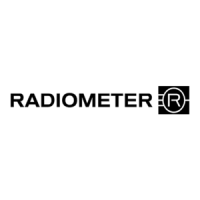ABL90 FLEX reference manual 5. Sensors and optical system
5-41
The absorbance (A) of a compound is defined as the logarithm of the ratio of the
light intensity before and after transmission through the compound.
In practice it is the logarithm of the ratio of the light intensity transmitted
through water to the light intensity transmitted through the compound.
0
=log
I
A
I
where:
0
I
=
intensity of light transmitted through water (
I
0
is measured as the
intensity of light transmitted through CAL 3 solution)
I
= intensity of light transmitted through the compound
For samples containing more than one optically active compound, the total
absorbance (A
total
) is the sum of the individual compounds’ absorbance, since
absorbance is an additive quantity.
For example, if a sample contains six compounds y
1
, y
2
, ….y
6
, the total
absorbance measured for that sample at wavelength
1
is:
1 11111
6
12345
1
y
total
yyyyy
AAAAAA
111111
123456
123456
yyyyyy
yyyyyy
lc c c c c c
If there are Y compounds and measurements are taken at
n wavelengths, a
general expression can be written for
A
total
at the wavelength
n
:
Y
yy
total
y1
Acl
n
n
where:
n
= the individual wavelengths.
n
A
total
can be depicted graphically as a function of wavelength, and if the
differences between the wavelengths are small enough, a continuous spectrum
is produced.
Absorbance
Total
absorbance
Continuous
spectrum

